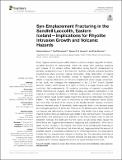Files in this item
Syn-emplacement fracturing in the sandfell laccolith, eastern iceland—implications for rhyolite intrusion growth and volcanic hazards
Item metadata
| dc.contributor.author | Mattsson, Tobias | |
| dc.contributor.author | Burchardt, Steffi | |
| dc.contributor.author | Almqvist, Bjarne S.G. | |
| dc.contributor.author | Ronchin, Erika | |
| dc.date.accessioned | 2020-11-16T12:30:36Z | |
| dc.date.available | 2020-11-16T12:30:36Z | |
| dc.date.issued | 2018-02-05 | |
| dc.identifier | 271111714 | |
| dc.identifier | 3c6451a7-a4fe-413f-a013-ee3fb93a6b64 | |
| dc.identifier | 85043603158 | |
| dc.identifier.citation | Mattsson , T , Burchardt , S , Almqvist , B S G & Ronchin , E 2018 , ' Syn-emplacement fracturing in the sandfell laccolith, eastern iceland—implications for rhyolite intrusion growth and volcanic hazards ' , Frontiers in Earth Science , vol. 6 , 5 . https://doi.org/10.3389/feart.2018.00005 | en |
| dc.identifier.issn | 2296-6463 | |
| dc.identifier.other | ORCID: /0000-0003-0717-4014/work/83890081 | |
| dc.identifier.uri | https://hdl.handle.net/10023/20984 | |
| dc.description | Field work was funded by Uddeholms travel stipend (Värmlands nation, Uppsala, Sweden), Otterborgs travel stipend and the Swedish Royal Academy of Science (KVA). The research was funded by the Swedish Research Council (VR) grant 2015-03931_VR. ER is funded by the Center of Natural Hazards and Disaster Science (CNDS). | en |
| dc.description.abstract | Felsic magma commonly pools within shallow mushroom-shaped magmatic intrusions, so-called laccoliths or cryptodomes, which can cause both explosive eruptions and collapse of the volcanic edifice. Deformation during laccolith emplacement is primarily considered to occur in the host rock. However, shallowly emplaced laccoliths (cryptodomes) show extensive internal deformation. While deformation of magma in volcanic conduits is an important process for regulating eruptive behavior, the effects of magma deformation on intrusion emplacement remain largely unexplored. In this study, we investigate the emplacement of the 0.57km3 rhyolitic Sandfell laccolith, Iceland, which formed at a depth of 500m in a single intrusive event. By combining field measurements, 3D modeling, anisotropy of magnetic susceptibility (AMS), microstructural analysis, and FEM modeling we examine deformation in the magma to constrain its influence on intrusion emplacement. Concentric flow bands and S-C fabrics reveal contact-parallel magma flow during the initial stages of laccolith inflation. The magma flow fabric is overprinted by strain-localization bands (SLBs) and more than one third of the volume of the Sandfell laccolith displays concentric intensely fractured layers. A dominantly oblate magmatic fabric in the fractured areas and conjugate geometry of SLBs, and fractures in the fracture layers demonstrate that the magma was deformed by intrusive stresses. This implies that a large volume of magma became viscously stalled and was unable to flow during intrusion. Fine-grained groundmass and vesicle-poor rock adjacent to the fracture layers point to that the interaction between the SLBs and the flow bands at sub-solidus state caused the brittle-failure and triggered decompression degassing and crystallization, which led to rapid viscosity increase in the magma. The extent of syn-emplacement fracturing in the Sandfell laccolith further shows that strain-induced degassing limited the amount of eruptible magma by essentially solidifying the rim of the magma body. Our observations indicate that syn-emplacement changes in rheology, and the associated fracturing of intruding magma not only occur in volcanic conduits, but also play a major role in the emplacement of viscous magma intrusions in the upper kilometer of the crust. | |
| dc.format.extent | 16742088 | |
| dc.language.iso | eng | |
| dc.relation.ispartof | Frontiers in Earth Science | en |
| dc.subject | Cryptodome | en |
| dc.subject | Intrusion emplacement | en |
| dc.subject | Laccolith | en |
| dc.subject | Magma degassing | en |
| dc.subject | Magma flow | en |
| dc.subject | Strain localization | en |
| dc.subject | Volcanic hazards | en |
| dc.subject | GE Environmental Sciences | en |
| dc.subject | Earth and Planetary Sciences(all) | en |
| dc.subject | DAS | en |
| dc.subject.lcc | GE | en |
| dc.title | Syn-emplacement fracturing in the sandfell laccolith, eastern iceland—implications for rhyolite intrusion growth and volcanic hazards | en |
| dc.type | Journal article | en |
| dc.contributor.institution | University of St Andrews. School of Earth & Environmental Sciences | en |
| dc.identifier.doi | 10.3389/feart.2018.00005 | |
| dc.description.status | Peer reviewed | en |
This item appears in the following Collection(s)
Items in the St Andrews Research Repository are protected by copyright, with all rights reserved, unless otherwise indicated.

